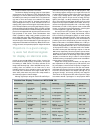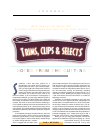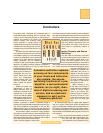
the emotion, the mood, the action, the transfor-
mation lead the cut, rather than the other way
around. I don’t like to let picture cuts fall on
hard consonants, as that emphasizes a cut.
I enjoy prelaps to pull the narrative
along – that is, starting an incoming
line of dialog over an outgoing
scene – provided it doesn’t become
a mannerism. I generally detest
what I call the never-let-a-mod-
ulation-die-out-before-you-cut-
away school of editing, which
in our attention-deficit age
is becoming more and
more common.
When most people are
impressed by editing they usually
think of elaborate action
sequences, but the real art of editing
lies in working with performances
and in concealment. What I care
about most is achieving a theatri-
cal sense of performance but
with filmic means. By the-
atrical, I don’t mean
ostentatious “acting”;
rather, I am referring
to the continuity you
get from a perfor-
mance on stage, the
building up and
releasing of tension
and emotion in an
unbroken arc of
time and space.
This can be
achieved on film,
but it is more
difficult because
films are made in
pieces and over
time. Usually the
master shots are done first. In a long scene,
allowing for camera setups, lighting, and rig-
ging, the director may not get around to
the close-ups until the end of the day
or the next day. Yet the shots have to
cut together. Sometimes one
actor will have his close-ups
before lunch, the other after
lunch; and emotionally, psycholog-
ically, even physiologically they’re
in completely difference places. Yet
the shots have to cut together. When scenes
involve several characters, each actor has his or her dif-
ferent way of working; they reach emotional peaks or
descend into emotional valleys at different times. Yet
the shots have to cut together. More often than not,
one actor will nail the scene in the first few
takes and setups (meaning the master),
another will not hit his stride until the
medium shots and over-the-shoulders,
and a third finally comes up to
speed in the close-ups. Yet still the
shots have to cut together.
It’s a funny thing about matching in editing. Most lay
moviegoers who pay attention to editing admire the elegance
of the shot matching; most editors brag about the mismatch-
es they manage to get away with. What experienced editors
care most about matching is the mood and emotion of the per-
formance from one shot to the next. (Even a volatile perfor-
mance that swings between extremes must have the integrity
of its changes.) Neophytes usually worry about quite trivial
matters – how much of the cigarette was burned away in this
shot as opposed to the previous one. The second scene I ever
had to cut was in a movie called The Best of Times. Kurt Rus-
sell and Robin Williams are at a bar drinking beer out of bot-
tles. The scene was covered from every conceivable angle and
size except that there were no singles – that is, a shot that con-
tains only one character. Every shot was some variety of a
two-shot, which means not only that both actors were plainly
visible, but so were their beer bottles. What a learning experi-
ence! Every time I wanted to make a cut, one bottle or the
other got in the way. Soon enough I discovered what every
editor discovers – the hell with matching. You cut for mood,
emotion, for the feeling of the moment, and then later correct
any mismatches you can’t live with.
In the scene I just described, the only cut I don’t like is the
one I absolutely had to make for the match alone: after one of
the actors delivered his line, I had to wait for him to raise the
bottle to his lips because that is where it was in the incoming
take that was best for the next line. I’d have rather cut away
sooner, but there was no other way without leaving a mis-
match so grotesque as to throw any moviegoer right out of the
moment. When I ran this scene for Garth Craven, one of my
mentors, he remarked, “Never give an actor a prop.”
Garth did not, I must add, say this to the detriment of the
actor; it was just commiseration between editors. The takes in
question were made hours apart; no actor can be expected to
turn in a good performance at the same time as he’s trying to
keep precise track of what are supposed to be casual swigs of
beer during a long scene in a neighborhood bar. That’s one of
the things editors are for.
There was a time when studio previews served an
admirable and necessary function, or complex of functions.
They let you observe how your movie played in front of an
The scr eenpl ay has a
st r uct ur e. Each scene has a
st r uct ur e – a r ange of t empos.
But t hese t hings have no r eal ci n-
emat i c exist ence unt i l t hey
l eave t he edi t or ’ s


















